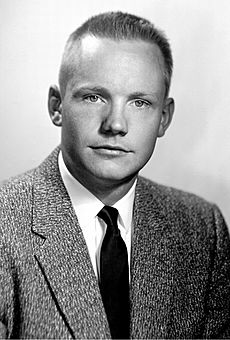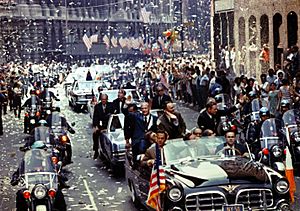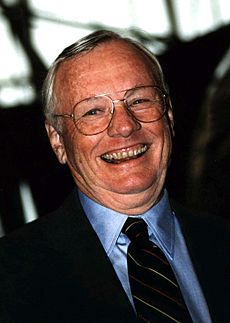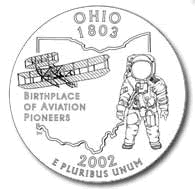Neil Armstrong facts for kids
Quick facts for kids
Neil Armstrong
|
|
|---|---|
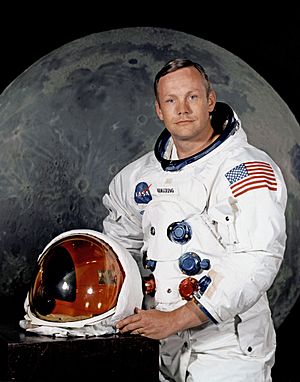
Armstrong in 1969
|
|
| Born |
Neil Alden Armstrong
August 5, 1930 Wapakoneta, Ohio, U.S.
|
| Died | August 25, 2012 (aged 82) Cincinnati, Ohio, U.S.
|
| Alma mater | |
| Awards |
|
| Space career | |
| USAF / NASA astronaut | |
|
Previous occupation
|
|
| Rank | Lieutenant (junior grade), USN |
|
Time in space
|
8 days 14 hours 12 minutes and 30 seconds |
| Selection |
|
|
Total EVAs
|
1 |
|
Total EVA time
|
2 hours 31 minutes |
| Missions |
|
|
Mission insignia
|
  |
| Spouse(s) |
Janet Shearon
(m. 1956; div. 1994)Carol Knight
(m. 1994) |
| Children | 3 |
| Signature | |
 |
|
Neil Alden Armstrong (August 5, 1930 – August 25, 2012) was an American astronaut and aeronautical engineer who became the first person to walk on the Moon in 1969. He was also a naval aviator, test pilot, and university professor.
Contents
Early years
Armstrong was born near Wapakoneta, Ohio, on August 5, 1930, the son of Viola Louise (née Engel) and Stephen Koenig Armstrong. He was of German, English, Scots-Irish, and Scottish descent. He is a descendant of Clan Armstrong. He had a younger sister, June, and a younger brother, Dean. His father was an auditor for the Ohio state government, and the family moved around the state repeatedly, living in 16 towns over the next 14 years.
The family's last move was in 1944 and took them back to Wapakoneta, where Armstrong attended Blume High School and took flying lessons at the Wapakoneta airfield. He earned a student flight certificate on his 16th birthday, then soloed in August, all before he had a driver's license. He was an active Boy Scout and earned the rank of Eagle Scout. As an adult, he was recognized by the Scouts with their Distinguished Eagle Scout Award and Silver Buffalo Award. While flying toward the Moon on July 18, 1969, he sent his regards to attendees at the National Scout jamboree in Idaho. Among the few personal items that he carried with him to the Moon and back was a World Scout Badge.
At age 17, in 1947, Armstrong began studying aeronautical engineering at Purdue University in West Lafayette, Indiana. Armstrong was also accepted to the Massachusetts Institute of Technology (MIT), but he resolved to go to Purdue after watching a football game between the Purdue Boilermakers and the Ohio State Buckeyes at the Ohio Stadium in 1945 in which quarterback Bob DeMoss led the Boilermakers to a sound victory over the highly regarded Buckeyes. An uncle who attended MIT had also advised him that he could receive a good education without going all the way to Cambridge, Massachusetts. His college tuition was paid for under the Holloway Plan. Successful applicants committed to two years of study, followed by two years of flight training and one year of service as an aviator in the U.S. Navy, then completion of the final two years of their bachelor's degree. Armstrong did not take courses in naval science, nor did he join the Naval Reserve Officers Training Corps.
Early career and education
Armstrong became a midshipman in 1949 and a naval aviator the following year.
He saw action in the Korean War, flying the Grumman F9F Panther from the aircraft carrier USS Essex. After the war, he completed his bachelor's degree at Purdue. Armstrong graduated with a Bachelor of Science degree in Aeronautical Engineering in January 1955. In 1970, he completed his Master of Science degree in Aerospace Engineering at the University of Southern California (USC). He would eventually be awarded honorary doctorates by several universities.
After graduating, he became a test pilot at the National Advisory Committee for Aeronautics (NACA) High-Speed Flight Station at Edwards Air Force Base in California.
He was the project pilot on Century Series fighters and flew the North American X-15 seven times. He was also a participant in the U.S. Air Force's Man in Space Soonest and X-20 Dyna-Soar human spaceflight programs.
Astronaut career
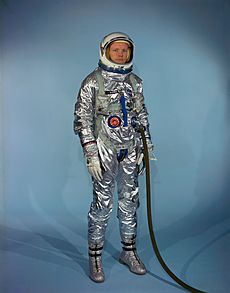
Armstrong joined the NASA Astronaut Corps in the second group, which was selected in 1962. He made his first spaceflight as command pilot of Gemini 8 in March 1966, becoming NASA's first civilian astronaut to fly in space. During this mission with pilot David Scott, he performed the first docking of two spacecraft. During training for Armstrong's second and last spaceflight as commander of Apollo 11, he had to eject from the Lunar Landing Research Vehicle moments before a crash.
On the Moon
Voyage to the Moon
A Saturn V rocket launched Apollo 11 from Launch Complex 39A at the Kennedy Space Center on July 16, 1969, at 13:32:00 UTC (09:32:00 EDT local time). Armstrong's wife Janet and two sons watched from a yacht moored on the Banana River. During the launch, Armstrong's heart rate peaked at 110 beats per minute.

The landing on the surface of the Moon occurred several seconds after 20:17:40 UTC on July 20, 1969. Armstrong confirmed the landing to Mission Control and the world with the words, "Houston, Tranquility Base here. The Eagle has landed." Aldrin and Armstrong celebrated with a brisk handshake and pat on the back.
First Moon walk
When Armstrong first stepped onto the lunar surface, he famously said: "That's one small step for [a] man, one giant leap for mankind." It was broadcast live to an estimated 530 million viewers worldwide.
Armstrong prepared his famous epigram on his own. In a post-flight press conference, he said that he chose the words "just prior to leaving the LM." In a 1983 interview in Esquire magazine, he explained to George Plimpton: "I always knew there was a good chance of being able to return to Earth, but I thought the chances of a successful touch down on the moon surface were about even money—fifty–fifty ... Most people don't realize how difficult the mission was. So it didn't seem to me there was much point in thinking of something to say if we'd have to abort landing."
About 19 minutes after Armstrong's first step, Aldrin joined him on the surface, becoming the second human to walk on the Moon. They began their tasks of investigating how easily a person could operate on the lunar surface. Armstrong unveiled a plaque commemorating the flight, and with Aldrin, planted the flag of the United States. Although Armstrong had wanted the flag to be draped on the flagpole, it was decided to use a metal rod to hold it horizontally. However, the rod did not fully extend, leaving the flag with a slightly wavy appearance, as if there were a breeze. Shortly after the flag planting, President Richard Nixon spoke to them by telephone from his office. He spoke for about a minute, after which Armstrong responded for about thirty seconds. In the Apollo 11 photographic record, there are only five images of Armstrong partly shown or reflected. The mission was planned to the minute, with the majority of photographic tasks performed by Armstrong with the single Hasselblad camera.
After helping to set up the Early Apollo Scientific Experiment Package, Armstrong went for a walk to what is now known as East Crater, 65 yards (59 m) east of the LM, the greatest distance traveled from the LM on the mission. His final task was to remind Aldrin to leave a small package of memorial items to Soviet cosmonauts Yuri Gagarin and Vladimir Komarov, and Apollo 1 astronauts Grissom, White and Chaffee. The Apollo 11 EVA lasted two and a half hours. Each of the subsequent five landings was allotted a progressively longer EVA period; the crew of Apollo 17 spent over 22 hours exploring the lunar surface. In a 2010 interview, Armstrong explained that NASA limited their Moon walk because they were unsure how the space suits would cope with the Moon's extremely high temperature.
Return to Earth
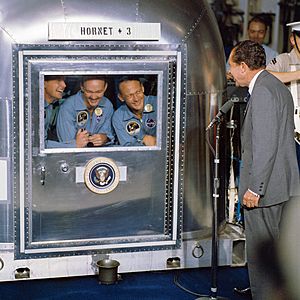
While preparing for liftoff, Armstrong and Aldrin discovered that, in their bulky space suits, they had broken the ignition switch for the ascent engine; using part of a pen, they pushed in the circuit breaker to start the launch sequence. Reaching the lunar orbit, the Eagle docked with Columbia, the command and service module. The three astronauts returned to Earth and splashed down in the Pacific Ocean, to be picked up by the USS Hornet.
After being released from an 18-day quarantine to ensure that they had not picked up any infections or diseases from the Moon, the crew was feted across the United States and around the world as part of a 38-day "Giant Leap" tour.
President Nixon and Vice President Agnew presented each astronaut with a Presidential Medal of Freedom.
In May 1970, Armstrong traveled to the Soviet Union, where he was the first westerner to see the supersonic Tupolev Tu-144 and was given a tour of the Yuri Gagarin Cosmonaut Training Center, which he described as "a bit Victorian in nature".
Life after Apollo
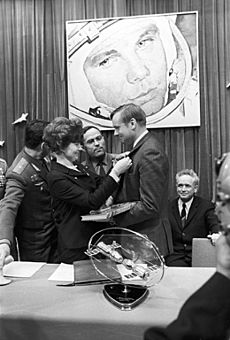
After he resigned from NASA in 1971, Armstrong taught in the Department of Aerospace Engineering at the University of Cincinnati until 1980. He served on the Apollo 13 accident investigation and on the Rogers Commission, which investigated the Space Shuttle Challenger disaster.
After Armstrong retired from NASA in 1971, he acted as a spokesman for several businesses. The first company to successfully approach him was Chrysler, for whom he appeared in advertising starting in January 1979. He later acted as a spokesman for other American companies, including General Time Corporation and the Bankers Association of America. In addition to his duties as a spokesman, he also served on the board of directors of several companies.
Personal life
Armstrong met Janet Elizabeth Shearon, who was majoring in home economics, at a college party. They were married on January 28, 1956, at the Congregational Church in Wilmette, Illinois.
The couple had three children: Eric, Karen, and Mark. In June 1961, Karen was diagnosed with a diffuse intrinsic pontine glioma, a malignant tumor of the middle part of her brain stem. She died of pneumonia, related to her weakened health, on January 28, 1962, aged two.
Armstrong and his first wife, Janet, separated in 1990 and divorced in 1994 after 38 years of marriage. He met his second wife, Carol Held Knight, at a golf tournament in 1992, when they were seated together at breakfast. She said little to Armstrong, but he called her two weeks later to ask what she was doing. She replied that she was cutting down a cherry tree, and he arrived at her house 35 minutes later to help. They were married in Ohio on June 12, 1994, and had a second ceremony at San Ysidro Ranch in California. They lived in Indian Hill, Ohio. Through his marriage to Carol, he was the father-in-law of future New York Mets general manager Brodie Van Wagenen.
Neil Armstrong quotes
His most famous quote is: "That's one small step for (a) man, one giant leap for mankind. "
He spoke those words when he set his foot on the moon. He wanted to say "That's one small step for a man…", but for some reason the "a" was never spoken. Armstrong thought he had said it. Listening to the audio shows that the "for" runs on smoothly, giving no time for "a" to be spoken. Armstrong prefers written quotations to include the "a" in parentheses.
Other quotes
- "Research is creating new knowledge."
- "Mystery creates wonder and wonder is the basis of man's desire to understand."
- "I believe every human has a finite number of heartbeats. I don't intend to waste any of mine."
Death
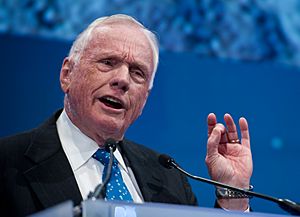
Armstrong underwent bypass surgery at Mercy Faith–Fairfield Hospital in Cincinnati on August 7, 2012, to relieve coronary artery disease. Although he was reportedly recovering well, he developed complications and died on August 25, aged 82.
A tribute was held for Armstrong on September 13, at Washington National Cathedral, whose Space Window depicts the Apollo 11 mission and holds a sliver of Moon rock amid its stained-glass panels. On September 14, Armstrong's cremated remains were scattered in the Atlantic Ocean from the USS Philippine Sea. Flags were flown at half-staff on the day of Armstrong's funeral.
Interesting facts about Neil Armstrong
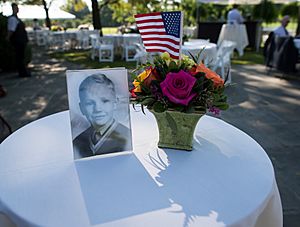
- Armstrong's love for flying started at the age of two when his father took him to the Cleveland Air Races.
- When he was five or six, he and his father took a ride in a Ford Trimotor in Warren, Ohio. That was his first airplane flight.
- When Armstrong applied at a local Methodist church to lead a Boy Scout troop in the late 1950s, he gave his religious affiliation as "deist".
- He was the second person in his family to attend college.
- In college, wrote and co-directed two musicals as part of the all-student revue.
- He was a baritone player in the Purdue All-American Marching Band.
- During the launch of Apollo 11, Armstrong's heart rate peaked at 110 beats per minute.
- In 1972, Armstrong visited the Scottish town of Langholm, the traditional seat of Clan Armstrong. He was made the first freeman of the burgh, and happily declared the town his home.
- In 1985, he travelled to the North Pole with an expedition. Armstrong said he was curious to see what it looked like from the ground, as he had seen it only from the Moon. He did not inform the media of the trip, preferring to keep it private.
- Between 1991 and 1993, he hosted First Flights with Neil Armstrong, an aviation history documentary series on A&E.
- In 2010, Armstrong voiced the character of Dr. Jack Morrow in Quantum Quest: A Cassini Space Odyssey, an animated educational sci-fi adventure film initiated by JPL/NASA through a grant from Jet Propulsion Lab.
- Armstrong guarded the use of his name, image, and famous quote. He sued Hallmark Cards in 1994, when they used his name, and a recording of the "one small step" quote, in a Christmas ornament without his permission.
- He used to autograph everything except first day covers. Around 1993, he found out his signatures were being sold online, and that most of them were forgeries, and stopped giving autographs.
- In May 2005, Armstrong became involved in a legal dispute with Mark Sizemore, his barber of 20 years. After cutting Armstrong's hair, Sizemore sold some of it to a collector for $3,000 without Armstrong's knowledge. Armstrong threatened legal action against Sizemore unless he returned the hair or donated the proceeds to a charity of Armstrong's choosing. Sizemore, unable to retrieve the hair, donated the proceeds to charity.
- The lunar crater Armstrong, 31 miles (50 km) from the Apollo 11 landing site, and asteroid 6469 Armstrong are named in his honor.
- There are more than a dozen elementary, middle and high schools named for Armstrong in the United States, and many places around the world have streets, buildings, schools, and other places named for him and/or Apollo.
- The Armstrong Air and Space Museum, in Armstrong's hometown of Wapakoneta, and the Neil Armstrong Airport in New Knoxville, Ohio, are named after him.
- The mineral armstrongite is named after him, and the mineral armalcolite is named, in part, after him.
- Armstrong's authorized biography, First Man: The Life of Neil A. Armstrong, was published in 2005. A film adaptation of the book, starring Ryan Gosling and directed by Damien Chazelle, was released in October 2018.
- In a 2010 Space Foundation survey, Armstrong was ranked as the number-one most popular space hero; and in 2013, Flying magazine ranked him number one on its list of 51 Heroes of Aviation.
Awards and honors
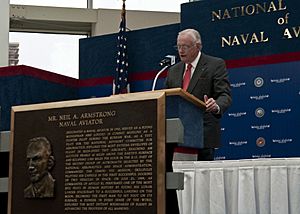
Apollo 11 was a major US victory in the Space Race.
Armstrong received many honors and awards, including the Presidential Medal of Freedom (with distinction) from President Nixon, the Cullum Geographical Medal from the American Geographical Society, and the Collier Trophy from the National Aeronautic Association (1969); the NASA Distinguished Service Medal and the Dr. Robert H. Goddard Memorial Trophy (1970); the Sylvanus Thayer Award by the United States Military Academy (1971); the Congressional Space Medal of Honor from President Jimmy Carter (1978); the Wright Brothers Memorial Trophy from the National Aeronautic Association (2001); and a Congressional Gold Medal (2011).
Armstrong was elected as member into the National Academy of Engineering in 1978 for contributions to aerospace engineering, scientific knowledge, and exploration of the universe as an experimental test pilot and astronaut. He was elected to the American Philosophical Society in 2001.

Armstrong and his Apollo 11 crewmates were the 1999 recipients of the Langley Gold Medal from the Smithsonian Institution. On April 18, 2006, he received NASA's Ambassador of Exploration Award. The Space Foundation named Armstrong as a recipient of its 2013 General James E. Hill Lifetime Space Achievement Award. Armstrong was also inducted into the Aerospace Walk of Honor, the International Space Hall of Fame, National Aviation Hall of Fame, and the United States Astronaut Hall of Fame. He was awarded his Naval Astronaut badge in a ceremony on board the aircraft carrier USS Dwight D. Eisenhower on March 10, 2010, in a ceremony attended by Lovell and Cernan.
In October 2004 Purdue University named its new engineering building Neil Armstrong Hall of Engineering. The NASA Dryden Flight Research Center was renamed the NASA Neil A. Armstrong Flight Research Center in 2014. In September 2012, the U.S. Navy named the first Armstrong-class vessel RV Neil Armstrong.
The planetarium at Altoona Area High School in Altoona, Pennsylvania is named after Neil Armstrong and is home to a Space Race museum. Similarly, a campsite in Camp Sandy Beach at Yawgoog Scout Reservation in Rockville, Rhode Island, is named in his honor, a nod to his Scouting career.
In July 2018, Armstrong's sons put his collection of memorabilia up for sale, including his Boy Scout cap, and various flags and medals flown on his space missions. A series of auctions was held on November 1 to 3, 2018, that realized $5,276,320. Two fragments of wood from the propeller and four pieces of fabric from the wing of the 1903 Wright Flyer that Armstrong took to the Moon fetched between $112,500 and $275,000 each.
Armstrong donated his papers to Purdue. Along with posthumous donations by his widow Carol, the collection consists of over 450 boxes of material. In May 2019, she donated two 25-by-24-inch (640 by 610 mm) pieces of fabric from the Wright Flyer, along with his correspondence related to them.
See also
 In Spanish: Neil Armstrong para niños
In Spanish: Neil Armstrong para niños



